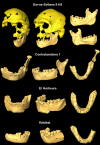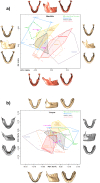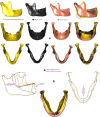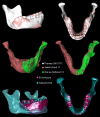The relevance of late MSA mandibles on the emergence of modern morphology in Northern Africa
- PMID: 35614148
- PMCID: PMC9133045
- DOI: 10.1038/s41598-022-12607-5
The relevance of late MSA mandibles on the emergence of modern morphology in Northern Africa
Abstract
North Africa is a key area for understanding hominin population movements and the expansion of our species. It is home to the earliest currently known Homo sapiens (Jebel Irhoud) and several late Middle Stone Age (MSA) fossils, notably Kébibat, Contrebandiers 1, Dar-es-Soltane II H5 and El Harhoura. Mostly referred to as "Aterian" they fill a gap in the North African fossil record between Jebel Irhoud and Iberomaurusians. We explore morphological continuity in this region by quantifying mandibular shape using 3D (semi)landmark geometric morphometric methods in a comparative framework of late Early and Middle Pleistocene hominins (n = 15), Neanderthals (n = 27) and H. sapiens (n = 145). We discovered a set of mixed features among late MSA fossils that is in line with an accretion of modern traits through time and an ongoing masticatory gracilization process. In Northern Africa, Aterians display similarities to Iberomaurusians and recent humans in the area as well as to the Tighenif and Thomas Quarry hominins, suggesting a greater time depth for regional continuity than previously assumed. The evidence we lay out for a long-term succession of hominins and humans emphasizes North Africa's role as source area of the earliest H. sapiens.
© 2022. The Author(s).
Conflict of interest statement
The authors declare no competing interests.
Figures







References
Publication types
MeSH terms
LinkOut - more resources
Full Text Sources
Miscellaneous

